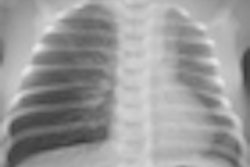
The radiation dose of CT can be reduced by up to 80% by manipulating different components of a scan, and it is possible to lower dose from 5 mSv to 1 mSv, Willi Kalender, PhD, told delegates at the radiation safety summit of the International Pediatric Radiology 2011 meeting, held in London from 27 to 31 May.
"Even with a high-power laser source for example, 80 Kv for angiography in adults, we can have a dose reduction of 50% without a loss in image quality and no detriments at all. This is ongoing work, and Siemens is developing a new option with 70 Kv," said Kalender, who is a professor and chairman of the Institute of Medical Physics at the Friedrich-Alexander-University of Erlangen-Nuremberg in Germany.
 Radiologists need to provide information, tell patients the effective dose, and relate that to natural background radiation, Dr. Willi Kalender told International Pediatric Radiology delegates on Friday.
Radiologists need to provide information, tell patients the effective dose, and relate that to natural background radiation, Dr. Willi Kalender told International Pediatric Radiology delegates on Friday.
In pediatrics, he has used a lower tube voltage on anatomical specimens and blood samples and found a big advantage. "We can reduce dose by greater than a factor of two without compromising image quality, because we have the same contrast-to-noise ratio. We cannot offer clinical cases yet, but we think we'll be there soon."
Providing a breakdown of where dose reductions could be made, Kalender reported that 20% could be saved with x-ray spectra, 30% on x-spectra detectors, 30% on dose management, and 40% on image reconstruction. In total, he said that it was possible to derive an 80% dose reduction. He illustrated his point with work first presented at the 2011 ECR. The dose reduction project aimed to improve early detection of breast cancer using a model of the female breast.
"We used photon-counting energy-discriminating CdTe detector technology, which allowed for improved dual-energy approaches. Importantly, it has 100% geometrical efficiency, so it is 20% to 30% better than all the detectors being used today," he said.
The breast model contained soft-tissue lesions and calcifications. The Erlangen researchers investigated whether CT could pick up calcifications. They were able to show that dedicated CT with new detector technology can provide spatial resolution of 100 µm, and the technique is expected to reveal microcalcifications smaller than seen in mammography. Their paper on this topic is currently in press with European Radiology.

Kalender emphasized CT had distinct advantages that had not been fully exploited. "Based on new detector technology, it is our goal to limit CT to the natural background exposure range and to have some applications which are in the sub-mSv range. I think we can reach this [goal] in this decade. We hope pediatric CT will follow this trend for sub-mSv applications."
The safety session culminated in a debate on whether radiologists should talk to families about informed consent and radiation protection.
Dr. Rutger Jan Nievelstein, from Wilhelmina Children's Hospital at University Medical Centre Utrecht in the Netherlands, presented the "yes" argument, agreeing to consent on provision that improvements were made to communication between referring physicians and radiologists, as well as access to and quality of electronic information for patients and physicians, including comparative risks, risks and benefits of alternative examinations, and risks of not performing the examination.
Dr. Donald Frush, chief of the division of pediatric radiology at Duke University Medical Center in Durham, North Carolina, U.S., presented the "no" argument. "The crux of the issue is the informed part, and patients, children, and even professional knowledge of radiation risks is limited."
Kalender was one of two judges, and he concluded: "If you say you give informed consent, can you really do this based on no evidence? We have information on benefits, saving millions of lives, but there is no good data on the risks in the low-dose range. We need to provide information, tell patients the effective dose, and relate that to natural background radiation."



















